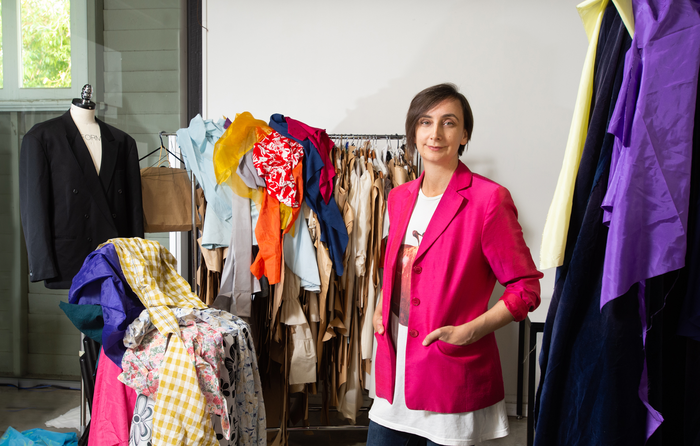Everyone can help create a world of more sustainable fashion
Sustainable fashion is not just a concern for high end designers – we can all make a difference by the choices we make

[August 18, 2021: QUEENSLAND UNIVERSITY OF TECHNOLOGY]
Repairing clothes, buying second hand, purchasing direct from the maker, reading labels, lobbying for change via social media platforms and not being a slave to trends are all actions individuals can take to encourage a new, more ethical order of fashion says a QUT researcher.
Around 100 million tonnes of fibre is produced each year and some 92 million tonnes of textile waste are discarded in the same period, an unsustainable situation in which everyone participates whether dressed in PPEs, tracksuit pants, uniforms, skinny jeans, designer dresses, or smart suits.
Associate Professor Alice Payne says even small changes from individuals, paired with larger scale industry and policy measures could help make the current system ‘less bad’ for the environment and workers within it. A project leader with QUT’s Centre for a Waste-Free World and a speaker at the Lunchtime lecture: Dreaming of a Waste Free World event during QUT’s Sustainability Week (23-27 August), some of the inspiring examples of changes she cites include:
‘Taming waste’ using advanced remanufacturing and other measures to recycle fast fashion fibres
Innovation in biotextiles and other renewable materials to move away from the heavy reliance on non-renewable polyester
Approaches to better connect everyone in the system, from fibre manufacturers, retailers, wearers to charities and recyclers
Growing consumer behavioural change: how people are sharing, swapping, and finding alternative ways to engage in fashion beyond industry dictates, including inventive approaches to repair
Initiatives around the world fighting to improve worker welfare
Manufacturers’ innovation in better management of chemical inputs and wastewater, and
The opportunities presented through traceability technologies that can powerfully connect everyone throughout fashion’s complex supply chains
“‘Sustainable fashion’ may be defined as systems of clothing production and use that are environmentally responsible, contribute to the social wellbeing of workers and the wider community, and are based on values of cultural respect,” said Associate Professor Payne who has a new book on the subject - Designing Fashion’s Future: Present Practice and Tactics for Sustainable Change (Bloomsbury).
“What is considered design in fashion is trivialised, feminised or brought into the rarefied world of art and serves to disguise how design in fashion actually functions. Exalted high end designers such as Chanel or McQueen represent only the tiniest portion of design practice in fashion.
“My book is not about them. Instead, I have sought to understand the design processes and practices of those who create everyday items like socks and t-shirts, as well as the many other decision-makers who help bring into being these humble objects. These people and their design processes clothe the world from cradle to grave, and their practices design fashion’s future.”
Associate Professor Payne sees the dominant form of fashion system as composed of four networks of production, promotion, wearing and destruction, all of which are out of sync with one another.
“In the dominant system, fashion’s industry and culture are bound up with an unsustainable pace of change, provoking the continual creation and destruction of new garments and the continual piquing of desire without satiation,” she said.
“A ‘better’ fashion system is certainly possible, but everyone needs to take some responsibility – if you wear clothes, you are part of it. In the past decade fashion sustainability ‘awareness’ has risen exponentially but so has pollution, waste, and overconsumption.”
By digging into the root causes of fashion’s unsustainability, Associate Professor Payne proposes the imperfect but essential actions to take for change, and how these can be defined for an individual – whether designer, brand owner or everyday wearer – as their own ‘ethical action space’.
“The book is not ‘optimistic’. Nor does it claim ‘sustainability’ is ever possible. Amid climate crisis and growing inequality, we may see few reasons to be optimistic. Rather, a way through the doom is to reject vague optimism and embrace hope, which can be expressed through actions,” she said.
“Think about the issues that matter to you – whether biodiversity, justice for workers, tackling climate change, poverty, and that can become your ethical action space.
“In the short-term, it’s about seeking to make things better in the immediate and near future, within the scope of one’s own ethical action space. For me that includes working with colleagues, community, and industry partners in finding the new processes and technologies to re-evaluate waste, here in Australia.
“A long-term agenda for fashion’s designers is to prepare our organisations, firms, communities in which we work for a resource-constrained future, one that is cleaner and lower-carbon through necessity, yet one in which economies and communities may be struggling to adapt. Fashion as culture, expressive of community and identity, will find new ways to flourish within these limits.”
Designing Fashion’s Future: Present Practice and Tactics for Sustainable Change (Bloomsbury) will be launched at Avid Reader in Brisbane on Friday 27 August. To book into QUT’s Lunchtime lecture: Dreaming of a Waste Free World on Monday 23 August, visit the Sustainability Week page.
For more environmental news stories check out our Green Impact section at The Brighter Side of News.
Like these kind of feel good stories? Get the Brighter Side of News' newsletter.
Tags: #Green_Good_News, #Fashion, #Recycling, #Waste, #The_Brighter_Side_of_News



